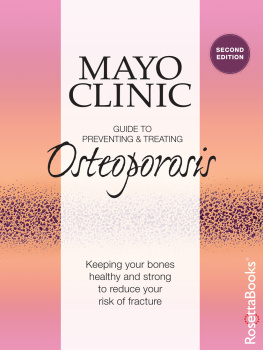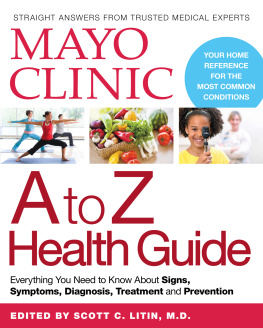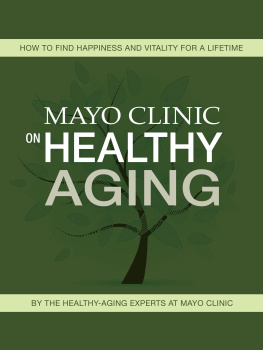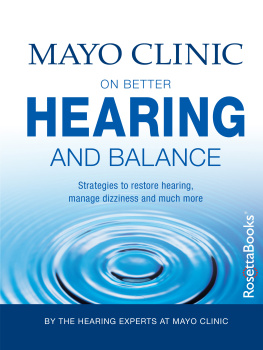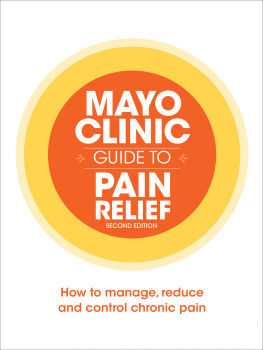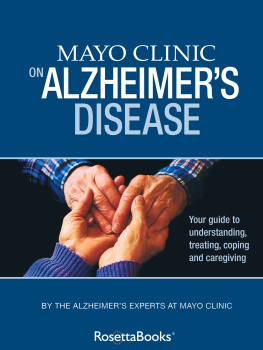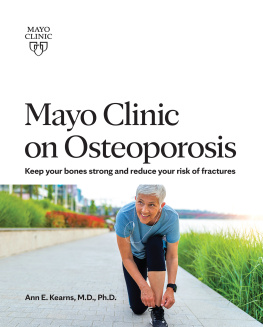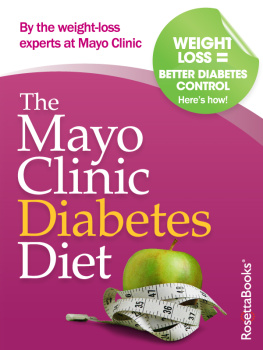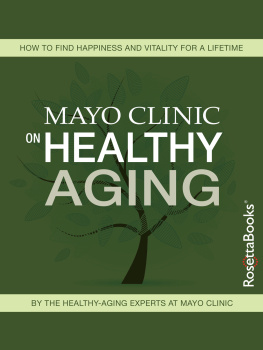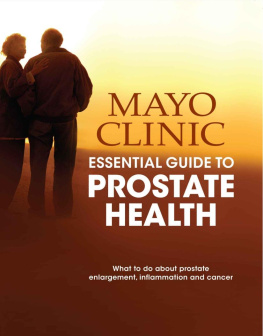
MAYO
CLINIC
GUIDE TO
PREVENTING & TREATING
Osteoporosis

Bart L. Clarke, M.D.
Medical Editor
Mayo Clinic
Rochester, Minnesota
Mayo Clinic Guide to Treating & Preventing Osteoporosis provides reliable, practical information on understanding and managing this common bone disorder. Much of the information comes directly from the experience of osteoporosis specialists and other health care professionals at Mayo Clinic. This book supplements the advice of your physician, whom you should consult for individual medical problems.
Mayo Clinic Guide to Treating & Preventing Osteoporosis does not endorse any company or product. MAYO, MAYO CLINIC and the Mayo triple-shield logo are marks of Mayo Foundation for Medical Education and Research.
All rights reserved. No part of this book may be reproduced or used in any form or by any means, electronic or mechanical, including photocopying and recording, or by any information storage and retrieval system, without permission in writing from the publisher, except by a reviewer, who may quote brief passages in review.
For bulk sales to employers, member groups and health-related companies, contact Mayo
Clinic Global Business Solutions, 200 First St. SW,
Rochester, MN 55905, or send an email to
SpecialSalesMayoBooks@Mayo.edu.
Published by Mayo Clinic
2014 Mayo Foundation for Medical Education and Research (MFMER)
Second Edition
ISBN EPUB edition: 9780795342264
Editorial staff
Medical Editor
Bart L. Clarke, M.D.
Managing Editor
Karen R. Wallevand
Editorial Director
Paula Marlow Limbeck
Product Manager
Christopher C. Frye
Art Director
Richard A. Resnick
Illustration and Photography
Michael A. King
Jodi OShaughnessy Olson
James E. Rownd
Research Manager
Deirdre A. Herman
Research Librarian
Erika A. Riggin
Proofreading
Miranda M. Attlesey
Donna L. Hanson
Julie M. Maas
Indexing
Steve Rath
Contributors
Mark E. Bolander, M.D.
Matthew T. Drake, M.D., Ph.D.
Daniel L. Hurley, M.D.
David F. Kallmes, M.D.
Ann E. Kearns, M.D., Ph.D.
Kurt A. Kennel, M.D.
Sundeep Khosla, M.D.
L. Joseph Melton, M.D.
Brian P. Mullan, M.D.
Jennifer K. Nelson, R.D., L.D.
Mehrsheed Sinaki, M.D.
Robert D. Tiegs, M.D.
Robert A. Wermers, M.D.
Administrative Assistant
Beverly J. Steele
Preface
Your life doesnt have to be upended by weakened bones. Osteoporosis was once considered an unfortunate result of growing old. Today thanks in large part to years of progressive research by investigators at Mayo Clinic and elsewhere we know that bone loss from osteoporosis can often be avoided or effectively managed. Future generations no longer have to experience the pain and disability once caused by this disease.
This new edition of Mayo Clinic Guide to Preventing & Treating Osteoporosis provides updated information on a variety of factors doctors consider in assessing your bone health and your risk of osteoporosis. The book includes a comprehensive, take-charge approach to diagnosing and managing osteoporosis, as well as detailed information and guidance on diet, supplements, exercise, medications and pain control.
You will learn how to reduce your risk of fracture due to falling. Youll also read about the importance of good posture, fitness, and balance and coordination. In addition, theres information on the latest advances in medications and advice on how to evaluate your treatment options.
Mayo Clinic doctors who specialize in osteoporosis have reviewed the chapters to ensure that you receive the most accurate and up-to-date information.
We believe youll find this book to be a helpful resource for effectively preventing and treating osteoporosis. Use of the strategies described in these pages, together with the support of family and friends and the guidance of your personal physician, can offer you the best opportunity to prevent bone loss and continue to live an active and independent life.
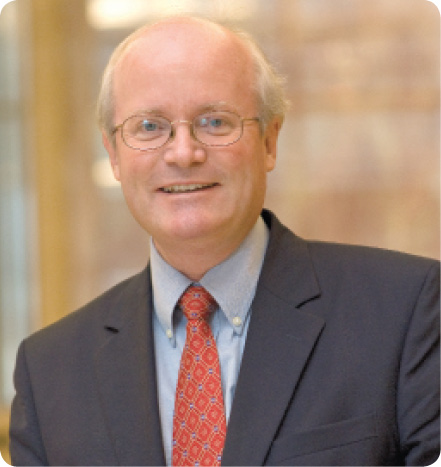
Bart L. Clarke, M.D.
Medical Editor
Table of contents
Part 1
Understanding osteoporosis
Chapter 1
What is osteoporosis?
You may not think of your bones as being alive, but they are. Every day, your body breaks down old bone and replaces it with new. As you get older, however, the ratio becomes unequal: You lose more bone than you gain. If you lose too much, you can develop the bone disease osteoporosis.
Osteoporosis causes bones to become weak, brittle and prone to fracture. The word osteoporosis means porous bones. Its an apt description of what happens to your skeleton if you have the disease. Due to loss of bone tissue, bones that were once dense and strong may be unable to withstand the stress of even normal activity, such as bending over or twisting to look behind you.
Until recently, osteoporosis was considered a natural part of aging, similar to getting gray hair or developing wrinkles. But theres nothing natural, or healthy, about losing 4 inches of height. And it certainly isnt natural to break a bone from coughing or receiving a hug.
But thats precisely what can happen if youre one of the more than 40 million Americans who have osteoporosis or are at high risk due to reduced bone mass.
The good news is the disease is as preventable and treatable as it is common. The keys to successfully avoiding osteoporosis are building a strong skeleton when youre young and slowing the rate of bone loss as you age. Even if you already have osteoporosis, good nutrition, exercise and medications can slow, or even reverse, its progression. Its never too late to do something about your bone health.
Osteoporosis risks
Each year osteoporosis is responsible for more than 2 million fractures. Typically these fractures occur in the spine, hip or wrist, but they may happen in other bones as well. A compression fracture of the spine causes your vertebrae to collapse and may lead to lost inches of height and a stooped posture. Fractures of the hip can change lives. Only about one-third of those who break a hip return to being as active as they were before the fracture. And nearly one-third go to a nursing home permanently. As if thats not enough, add chronic pain and feelings of anxiety and depression to the mix of problems that osteoporosis can cause.
Osteoporosis is most common among postmenopausal women. If youre a female age 50 or older, you have an eye-opening 50 percent chance of breaking a bone during your remaining lifetime. Statistics indicate your risk of breaking a hip is about the same as your combined risk of developing breast, uterine or ovarian cancer. Although fewer men than women get osteoporosis, men have a higher risk of death after breaking a hip.
Many people have weak bones and dont even know it. Thats because bone loss typically happens over a long period of time and it doesnt hurt. Oftentimes, a broken bone is the first and only indication that a person may have osteoporosis. Unfortunately, by the time a fracture occurs, the disease is often well-established. A bone density test is the best way to predict fracture risk.
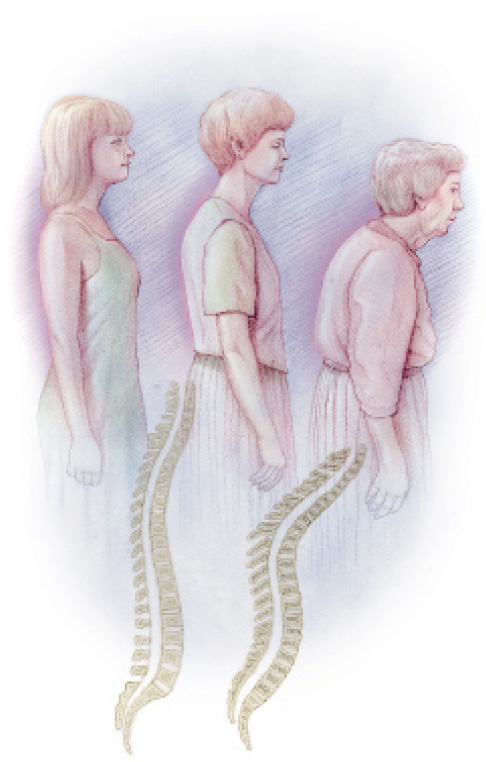
Next page
